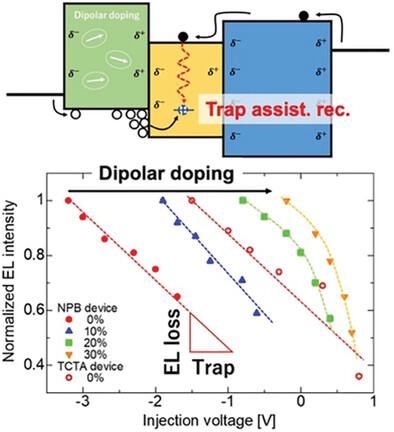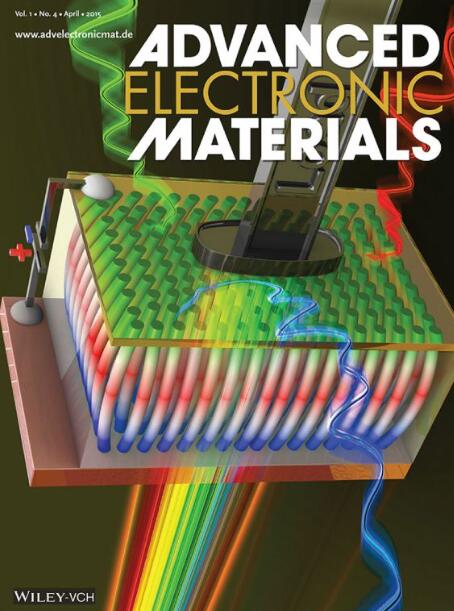Degradation Properties of Organic Light-Emitting Diodes with Modified Interface Charge Density via Dipolar Doping Studied by Displacement Current Measurement
IF 5.3
2区 材料科学
Q2 MATERIALS SCIENCE, MULTIDISCIPLINARY
引用次数: 0
Abstract
Accumulated charges at the interfaces of organic light-emitting diodes (OLEDs) often induce exciton quenching and lead to device degradation. This work delves into the correlations of the interface charge accumulation and degradation properties of tris(8-quinolinolato)aluminum (Alq3)-based OLEDs. The interface accumulated charge density is modified by spontaneous orientation polarization (SOP) induced in the hole transport layer (HTL) by means of dipolar doping, where N,N′-bis(1-naphthyl)-N,N′-diphenyl-1,1′-biphenyl-4,4′-diamine (NPB) or tris(4-carbazoyl-9-ylphenyl) amine (TCTA) is employed as a hole transport material and 2,2′,2″-(1,3,5-Benzinetriyl)-tris(1-phenyl-1-H-bensimidazole) (TPBi) as a dipolar dopant. It is confirmed that NPB cation acts as an exciton quencher, but TCTA cation does not, depending on the spectral overlap of Alq3 emission and the absorption of the respective cations. On the other hand, the TCTA devices degrade much faster than the NPB devices. Moreover, the device lifetime is similar or even shorter for the doped devices despite less interface charge density. These results suggest that holes accumulated at the interface between the hole transport material and Alq3 due to SOP are not mainly involved in the degradation mechanism. Furthermore, it is found that the charge traps generated due to degradation do not act as exciton quenchers, suggesting that they rather act as nonradiative recombination centers.

用位移电流测量研究了偶极掺杂改性界面电荷密度有机发光二极管的降解特性
有机发光二极管(OLED)界面上的电荷累积通常会诱发激子淬灭并导致器件降解。这项研究深入探讨了三(8-喹啉醇)铝(Alq3)基有机发光二极管的界面电荷累积与降解特性之间的相关性。通过双极性掺杂(其中 N,N′-双(1-萘基)-N,N′-二苯基-1,4-萘基-1,4-二苯基-1,4-萘基),在空穴传输层(HTL)中诱导的自发取向极化(SOP)改变了界面累积电荷密度、1′-联苯-4,4′-二胺(NPB)或三(4-咔唑酰-9-基苯基)胺(TCTA)作为空穴传输材料,2,2′,2″-(1,3,5-苯并三酰)-三(1-苯基-1-H-苯并咪唑)(TPBi)作为双极掺杂剂。根据 Alq3 发射光谱与各自阳离子吸收光谱的重叠情况,可以确认 NPB 阳离子是激子淬灭剂,而 TCTA 阳离子则不是。另一方面,TCTA 器件的衰减速度比 NPB 器件快得多。此外,尽管掺杂器件的界面电荷密度较低,但其器件寿命却与之相似,甚至更短。这些结果表明,SOP 在空穴传输材料和 Alq3 之间的界面上积累的空穴并不是降解机制的主要原因。此外,研究还发现,降解产生的电荷陷阱并不充当激子淬灭剂,而是充当非辐射重组中心。
本文章由计算机程序翻译,如有差异,请以英文原文为准。
求助全文
约1分钟内获得全文
求助全文
来源期刊

Advanced Electronic Materials
NANOSCIENCE & NANOTECHNOLOGYMATERIALS SCIE-MATERIALS SCIENCE, MULTIDISCIPLINARY
CiteScore
11.00
自引率
3.20%
发文量
433
期刊介绍:
Advanced Electronic Materials is an interdisciplinary forum for peer-reviewed, high-quality, high-impact research in the fields of materials science, physics, and engineering of electronic and magnetic materials. It includes research on physics and physical properties of electronic and magnetic materials, spintronics, electronics, device physics and engineering, micro- and nano-electromechanical systems, and organic electronics, in addition to fundamental research.
 求助内容:
求助内容: 应助结果提醒方式:
应助结果提醒方式:


